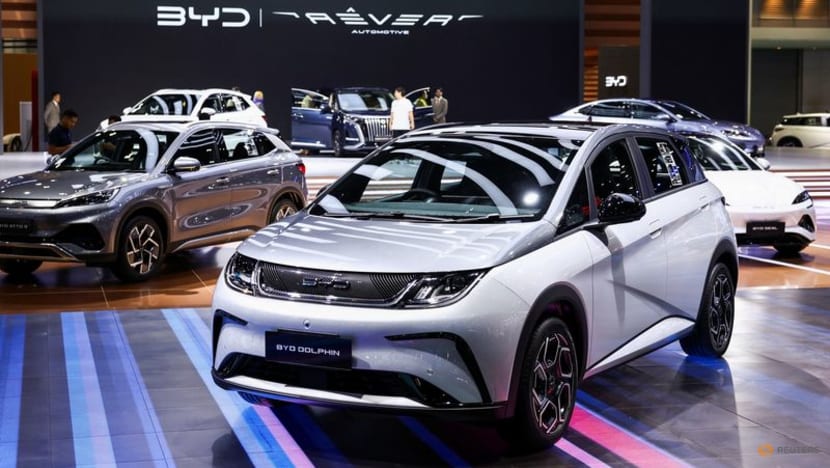CNA Explains: China's EVs and the quest for global dominance
CNA looks at the story behind Beijing's EV boom, the hurdles ahead and what it means for perceptions of "Made-in-China" products.

BYD EV cars are displayed at the 45th Bangkok International Motor Show in Bangkok, Thailand, on Mar 25, 2024. (File photo: Reuters/Chalinee Thirasupa)

This audio is generated by an AI tool.
SINGAPORE: Electric vehicle (EV) sales in China have risen year-on-year, according to data released this week.
But the industry also marked its slowest quarterly growth since early 2023. Top brand BYD in fact reported a quarterly drop in units sold, which led to US rival Tesla reclaiming its crown as the world's top EV seller.
Who are the biggest EV players in China?
BYD, founded in 1995 and headquartered in Shenzhen, instantly comes to mind. It launched the world's first plug-in hybrid EV in 2008.
Two other big names are Shanghai-based NIO, which entered the market in 2016, and Guangzhou-based XPeng which followed suit in 2018.
Chinese smartphone giants Huawei and Xiaomi have also thrown their hats into the ring.
How have Chinese EVs fared both domestically and globally?
In 2023, China sold a total of 8.9 million pure EVs and plug-in hybrids, the South China Morning Post reported. It is the world's biggest EV market, accounting for about 60 per cent of global sales.
Despite a slowdown in domestic demand, several Chinese EV makers reported double-digit sales growth in March. This has been attributed to the massive popularity of Xiaomi's SU7 car and BYD intensifying a price war by discounting many models.
While it recently ceded its top global EV seller title to Tesla, BYD's overtaking of Elon Musk's automaker in the previous quarter had been lapped up by Chinese state media, which referred to the "milestone" as a step towards Beijing becoming the world's biggest auto exporter.
In Southeast Asia, Chinese brands are also gaining popularity, accounting for about 75 per cent of the EV market, one analyst wrote.
BYD is the best-selling EV brand in both Singapore and Thailand, according to Intellisia Institute's Xirui Li in a CNA commentary last Tuesday (Apr 2).
The Ernst & Young consultancy expects the regional market to reach US$80 billion to US$100 billion in potential annual sales opportunities by 2035.
What's behind the rise of China's EVs?
The boom is largely driven by the Chinese government’s substantial supportive policies, wrote Li in her commentary.
According to S&P Global, China’s government began subsidising what they refer to as new-energy vehicles (NEVs) in 2009. It then set out its first industry development plan in 2012, which included targets such as production, ownership and vehicle mileage.
Among more than 5,000 mainland Chinese listed companies, five of the top 10 recipients of government grants during the first half of 2023 were local EV or battery manufacturers, a Nikkei report noted.
Almost all EVs sold in China are also exempt from a vehicle purchase tax, said Bloomberg.
The affordability of China's EVs plays a massive part.
Their average retail price has fallen over the years to cost just over US$34,000 as of 2022. This is 33 per cent less than the average price of a gasoline car.
“China’s focus has been to ensure that EVs were accessible for the masses, and it has done so to great success, developing its low-entry segments, and allowing demand to shift as smoothly as possible from (internal combustion engines) to EVs,” said David Krajicek, CEO of research firm JATO Dynamics.
One reason for its cheaper EVs is China’s dominance of the battery supply chain.
In 2022, Chinese manufacturers held a 60 per cent share of the global EV battery market. China also controls the production of battery materials like nickel, cobalt and lithium.
All of which gives its carmakers an edge in terms of EV production costs, said Moody’s analysts in a July 2023 report.
BYD, for one, makes many of its components in-house, including batteries, which alone account for about 30 per cent of a vehicle’s total cost, Nikkei Asia reported.
Analysis by investment bank UBS showed that BYD’s Seal electric sedan made 75 per cent of its components in-house, compared with 46 per cent for a Tesla Model 3 sedan made in China.
Last week, Reuters reported that Tesla had scrapped plans for a low-cost car which Musk had repeatedly promised to deliver and price around US$25,000.
Its cheapest model at present - the Model 3 - costs about US$39,000 in the United States, while there are Chinese EVs retailing for as little as US$10,000.
Analysts say that beyond appealing to the budget-sensitive, carmakers like BYD also have the design and manufacturing capabilities to churn out cars that are actual value-for-money.
What are the hurdles facing China's EVs?
Besides increasingly fierce domestic competition from new entrants such as Xiaomi, Chinese EV firms also face challenges trying to expand globally.
For one, the government's substantial subsidies to the EV sector have come under scrutiny.
China’s Minister of Commerce Wang Wentao has said however that the rapid development of Chinese EV manufacturers is a result of constant technological innovation, a well-established supply chain system and market competition instead.
Accusations by the United States and Europe of "overcapacity" are groundless, he added.
The European Commission has begun an investigation to determine whether to impose tariffs on exports to protect European car makers. It's due to conclude by November, although the EU executive could impose provisional duties earlier.
According to research company Rystad Energy, the EV landscape outside of China is “notably different”, with European markets stagnant and the US' lacklustre.
Still, "having the core ingredients – strong battery technology, a firm hold over the battery supply chain and operational advantages" is no guarantee of market leadership, said INSEAD business school's Chengyi Lin in an article published in the Harvard Business Review.
“Ultimate success lies beyond the product itself. Chinese EV companies need to ... learn about the global market – be it channels, competition, consumer behaviour or infrastructure."
Related:
Will EVs change perceptions of China-made products?
A study by the Association of Indonesia Automotive Industries showed about 66 per cent of consumers there had positive views of Chinese cars - citing the vehicles’ affordability, innovative features, mobility and comfort.
According to Intellisia Institute's Li, Chinese EVs’ popularity in Southeast Asia seems to show that the country is “increasingly recognised for technology development and high-tech products”, compared to “the old impression that China is merely the ‘world factory’ where ‘Made in China’ is seen as shorthand for cheap and low-value-added goods".
At a time when climate change is on many national and global agendas, China could leverage its EV dominance to win over partners, Li wrote.
But to what extent China’s EV boom will have an impact on its soft power projection depends on how Beijing copes with three challenges, she added.
First, domestic EV policies; second, making EV outbound investment the consensus across political factions in hosting countries; and third, the rapid internationalisation of its EV makers in the face of increasing geoeconomic and geopolitical competition with the West.
















